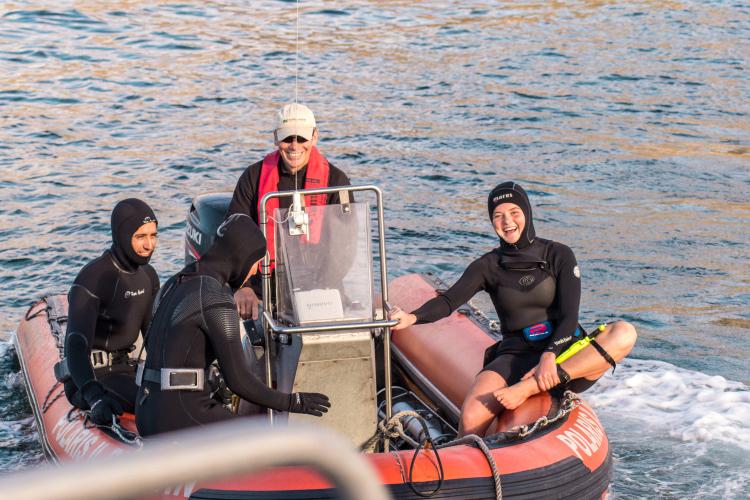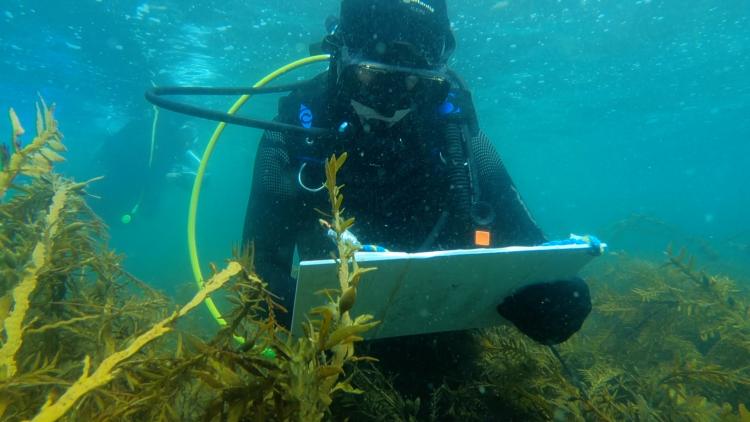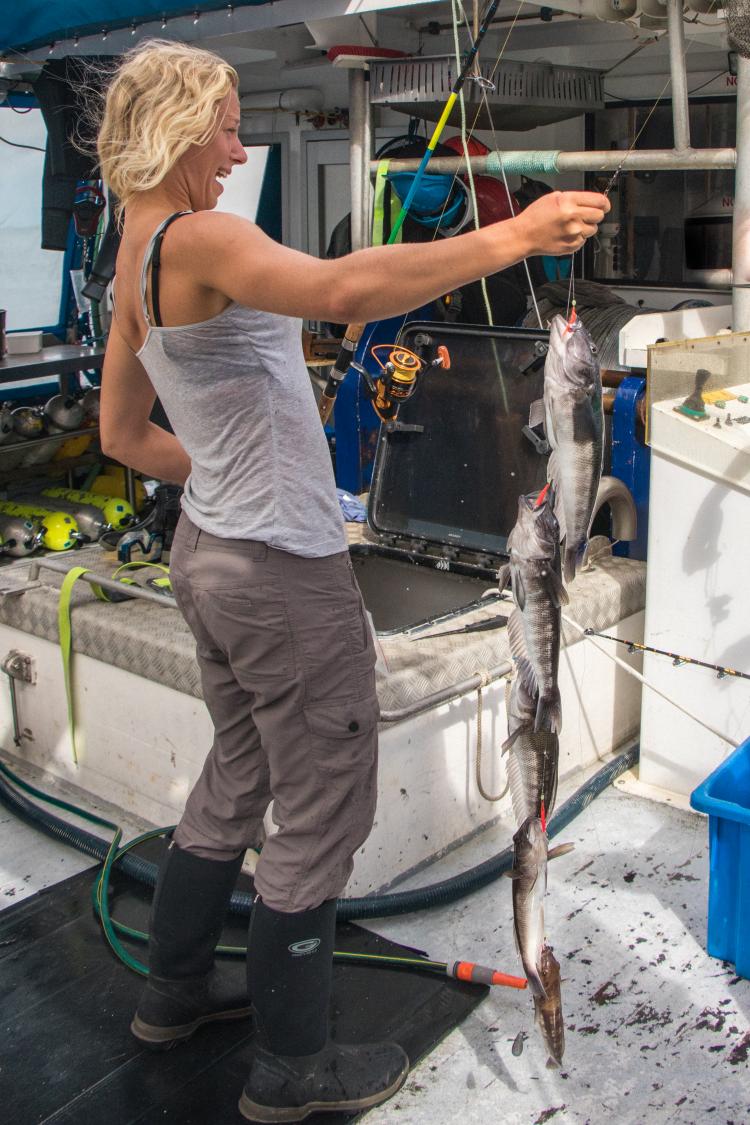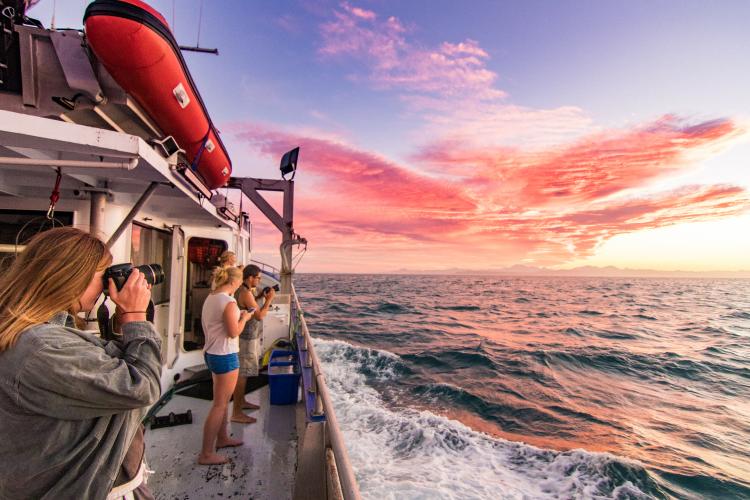Posted on 26 February 2018
Blog: Lana Young from RV Polaris II (week 2)
- News
- Dynamic Seas Tasman/Te Tai-o-Aorere Nelson/Whakatū Marlborough/Te Tauihu-o-te-waka Canterbury/Waitaha Otago/Ōtākou
- 7 Minutes to read
Lana, a student at the University of Otago, reports on life at sea and the fieldwork being done for our Ecosystem Connectivity project. This is her first research voyage.
14 February: Thunderbirds are go!
Today we deployed our little boat, perfect for zipping around quickly and getting to places that the Polaris II can’t. Lots of the sites we visit are used by more than one of the researchers, so every day we collect data for multiple projects at once. As well as using our time efficiently, any animals collected can be used resourcefully.
Rebecca and Stina jetted out to some salmon farms to do sediment grabs of the substrate next to the farms and drop CTD casts around the bay. Charlotte, Jacquetta, Steve and Leo then headed off to a shallower reef to snorkel for fish for their projects – being close to the fridge of the sounds and the ocean we’ve noticed some much larger fish, pāua and crayfish, and thicker kelp forests – likely due to the colder and more nutrient rich oceanic water input around here.

15 February: Teamwork
Another day of diving and counting fish and invertebrates. This involves teams of four laying out 50m transects along the reef at 15m and 5m. One buddy pair swims along the transect with a GoPro and clipboard, filming and recording the number and species of fish that they see. The other buddy pair follows closely, placing a quadrat along the transect and counting the invertebrates and seaweed within that square, taking pictures as they go. This data helps build a picture of the type of habitat, giving context to the researchers’ projects and data that is easily comparable between locations.
We also collected a few bivalves (two-shelled invertebrates like mussels), which Sorrel and Clara use for their research. Clara is looking at how the growth rate of bivalves varies between sites that are affected by humans and those which are relatively untouched. Boats, salmon farms, forestry and agriculture are just some of things that can increase the amount of sediment flowing into the sea. Bivalves are filter feeders: they suck water through their gills (to breathe), and filter out tiny miniscule particles of food. Increased amounts of sediment means it’s likely they use more energy to ‘sift’ through which particles are food and which aren’t. This may influence their growth rate, so Clara will compare these Marlborough bivalves with ones from similar habitat in Fiordland to investigate.

16 February: One, two, three, four, five, once I caught a fish alive…
This morning we ventured out into the Cook Strait bound for D’Urville Island, and focused on sampling some blue cod for Stina’s PhD research. Sorrel managed to catch five on one line!
Stina is investigating is growth and age. She takes measurements of as many blue cod as she can before letting them go, and also samples a few fish to work out their age from their ears(!) Fish have a small ear bone called an otolith that shows seasonal growth bands, so you can age them in the same way that you can tell how old a tree is counting its rings.
She’s also investigating sex ratios. Young blue cod are neither male or female; as they get older and bigger their sex is determined by hormones. However, females can change sex depending on what’s happening in the population. Males tend to be the largest, which poses a problem as large fish are more sought after commercially. Blue cod are highly territorial, so if a large male is taken out of a reef, it can really put the local sex ratio out of whack! To quickly replace the big male, many more female fish than needed will become males, and so the population ends up being heavily male biased – a big problem for sustaining the population. Stina’s examined hundreds of fish and the majority were males – a clear indication of the effects of human activities on the Sounds population.

17 February: Caution – cod nibbles nose
This morning we were especially excited as we were diving off Long Island in Queen Charlotte Sound, a marine reserve. Jacquetta is looking at how fish population structures vary inside and outside of a marine reserve. She couldn’t dive this site last summer due to the weather, so it was great to finally be able to tick it off.
Our high expectations were met. There was a noticeable increase in the diversity – and size! – of fish and invertebrates found at this site. Some of the largest blue cod we’d ever seen were very curious about us, and weren’t afraid to come right up to watch what we were doing. One even tried to nip Charlotte’s nose!
18 February: Making a run for it!
We had just 1m visibility for our last dive in the Sounds – thankfully we’ve had lots of practise of our data collection technique over the last few days so we still managed to get all the data we needed.
We’d been watching the weather forecast as ex-Cyclone Gita steadily makes her way to New Zealand. This morning it became clear that her trajectory is headed straight for Marlborough! Although we don’t have the speediest get-away boat, we decided it was probably a good idea to ‘make a run for it’ at our ever-so-fast speed of 8 knots and began the long journey south.
We enjoyed the most spectacular sunset. Being from Dunedin (on the east coast) we don’t often get to see a good sunset (in the west), but we had the best view of Blenheim’s coastline with the sun setting behind New Zealand.

19 February: ex-Cyclone Gita
We woke up to the buzz of the engines, and to find we were well en-route to the safety of Akaroa harbour. We avoided the swell by hugging the coastline, but were battered by offshore waves. These got us very wet if we braved the deck for some fresh air... as I found out!
As the day went on and Gita got closer, we left the shelter of the shore to cross towards Banks Peninsula. The direction of the swell changed, so we were back to rocking ‘n’ rolling in gradually worsening weather. Most of us curled up in our bunks to ride out the chaotic seas. We thankfully made it to calm waters but to our surprise we weren’t in Akaroa – Bill had made the decision to pull into Lyttelton Harbour, a much closer alternative that we were all thankful for!
20 February: Abandon ship
Settling in for the night, we dropped the anchor and had a delicious roast dinner with meat sourced from Steve’s lifestyle block, followed up with a round of cards and ice cream – what a treat!
With states of emergency being declared left, right and centre – we sat cosily in the galley (kitchen) this morning thankful that we had made it to the shelter of Lyttelton Harbour. Now that most of our research had been put on hold we had the perfect opportunity for entering data – the less glamorous (but still important) part of the job is some serious number crunching.
As Gita rolled closer the weather outlook wasn’t looking too promising. Our skipper, Bill, reckoned that it would be at least Thursday (22nd) night until we could leave! It was a 24-hour journey back to Dunedin by sea and the last bits of data we were hoping to collect are along the Munida transect – a longstanding research route just outside of the Dunedin harbour. The prospect of sitting around waiting to go home wasn’t too appealing and it’s easy to reach the Munida from Dunedin, so we abandoned ship and drove back to Dunedin that night. It wouldn’t have been a proper marine science field trip if everything went to plan! Working around the weather is a lesser-known skill that all marine scientists develop :)
Read Week 1